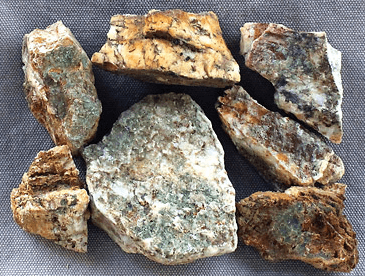In all experiments aimed at testing the gold content of rocks or “ore”, you should ask yourself whether the conditions of his test differ in any vital particular from those that would obtain on a commercial scale; if so, there is no guarantee that his results would be borne out in a working plant. Small scale experiments are very valuable if carefully and skilfully performed, but may be misleading and inconclusive if the proper precautions are not observed.
It is advisable first of all to examine the ore for visible gold and silver, the presence of which might influence the choice of a method of treatment. If no gold or native silver can be seen in the rock, take a representative sample of about 300 grams and grind it up to pass a No. 30 sieve. Weigh out 250 grams and carefully pan down until most of the gangue is removed. Examine the heavy residuum for metallics. Should any be found it will be well to see how much can be amalgamated.
How to Easily Test/Determine of rocks contain gold:
This may be made by putting about an ounce of gold-and-silver-free mercury in a small stoppered bottle and adding the heavy material from the pan with a little water, and agitating violently for 5 or 10 minutes. The mercury is then panned free from mineral, and the latter examined again with a pocket lens. The precious metal content of the mercury may be determined either by volatilization in the muffle or by dissolution in nitric acid.
If it is desired to estimate the whole amount of gold and metallic silver amalgamable in the ore, a similar experiment may be made by weighing up 250 grams of the pulp, diluting with water at 1:1, and agitating violently with mercury for about 30 minutes. The mercury is then panned from the pulp, and the latter assayed. The mercury may also be retorted, and the contents weighed, or, in the case of gold alone, the mercury may be dissolved in nitric acid. This test is likely to flour a large part of the mercury, but after being panned clean it may be collected by the addition of a little sodium amalgam.
For these amalgamation tests it is usually better to render the water in the pulp strongly alkaline with caustic soda, and to see that it remains alkaline throughout the experiment, but a test should also be made with plain water. It is also a useful precaution to weigh the mercury before and after the test.
Visible gold and silver are likely to give trouble in cyaniding unless ground exceedingly fine so as to accelerate the dissolving action, and when either of them is found it will be a question to be determined whether it would be better to amalgamate before cyaniding or grind the whole ore so fine that the metallics will be dissolved in the cyanide solution in a reasonable time.
If the ground ore be found to contain metallics an amalgamation test should be made on the ore prior to cyanidation for which purpose a kilo of the ground ore may be made into a pulp with water and passed over a small amalgamated copper plate several times.
The ore should also be tried by cyanidation under various conditions without previous amalgamation.
